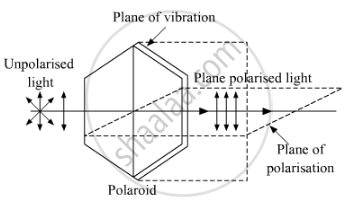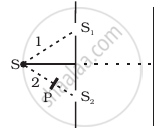Advertisements
Advertisements
Questions
Why does an unpolarised light incident on a polaroid get linearly polarised ?
How does one get linearly polarised light with the help of a polaroid?
Solution 1
When unpolarised light is passed through a polaroid crystal, only those vibrations of light pass through the crystal that are parallel to the axis of the crystal. All other vibrations will be absorbed by the crystal. In this way, the unpolarised light incident on a polaroid gets linearly polarised.

Solution 2
We get linearly polarised light with the help of a polaroid as shown below:

The naked eye or the polariser cannot distinguish between unpolarised and plane polarised light. A crystal called analyser is used to analyse the nature of light.
If the axis of the polariser and the analyser are parallel to each other, the intensity of light is found to remain unaffected.
APPEARS IN
RELATED QUESTIONS
For a glass plate as a polariser with refractive index 1.633, calculate the angle of incidence at which light is polarised.
If the critical angle of a medium is sin-1(3/5), find the polarising angle.
Two polaroids P1 and P2 are placed with their pass axes perpendicular to each other. An unpolarised light of intensity I0 is incident on P1. A third polaroid P3 is kept in between P1 and P2 such that its pass axis makes an angle of 30° with that of P1. Determine the intensity of light transmitted through P1, P2 and P3
The refractive indices of water for red and violet colours are 1.325 and 1.334 respectively.
Find the difference between the velocities of rays for these two colours in water. (c = 3 × 108 m/s)
State two uses of Polaroid.
What is the difference between polarised light and unpolarised light?
A ray of ordinary light is travelling in air. It is incident on air glass pair at a polarising angle of 56°. Find the angle of refraction in glass.
What is polarisation?
Can reflection result in plane polarised light if the light is incident on the interface from the side with higher refractive index?
Figure shown a two slit arrangement with a source which emits unpolarised light. P is a polariser with axis whose direction is not given. If I0 is the intensity of the principal maxima when no polariser is present, calculate in the present case, the intensity of the principal maxima as well as of the first minima.

